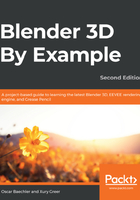
Modeling the rear assembly
We're finished with the interior pieces of the time machine. Before we get started on the last two pieces of the model, let's toggle the visibility of the interior and exterior reference images. Click on the eyeball icons for both of the "Interior" reference images in the Outliner to hide them. Next, click on the eyeball icons for both of the "Exterior" reference images in the Outliner to make them visible. Once that's done, we're ready to model the rear assembly.
The rear assembly isn't a terribly complicated piece. It requires a couple of simple extrusions, as well as some modifiers that will save us from having to model more than one of the repeated sections. We're going to start with the piece on the back of the headrest. Let's start by adding a plane:
- Go to the back view.
- Place the 3D Cursor near the middle of the headrest.
- Bring up the Add menu and choose Mesh | Plane.
- Open the Adjust Last Operation panel.
- Set Size to 0.22 m.
- Set Align to View.
- Set Location X to 0.
- Rename the new object RearAssembly.
Setting the Align option to View has rotated the object. This means that Blender thinks the object is not in its default rotation right now. This will cause a problem later, so we need to apply the rotation:
- Go to the Object menu at the top of the 3D View.
- Choose Apply – Rotation & Scale.
The object shouldn't look any different, but now, Blender recognizes its current orientation as its default, which is good! Next, let's get some symmetry and thickness going with modifiers:
- Go to the Modifiers tab.
- Add a mirror modifier to the RearAssembly object.
- Inside of the modifier's options, check the box that says clipping.
- Add a Solidify modifier.
- Set Thickness to 0.1 m.
The clipping option in the mirror modifier means that parts of the mesh that touch the symmetry line will "stick" to the symmetry line, which is very useful for making the object mirror seamlessly. You will see this in action now:
- Tab into Edit Mode.
- Press the A hotkey to select all of the components.
- Grab the components and move them to the left along the x-axis until the leftmost edge aligns with the edge of the reference image (see the following screenshot).
- Insert a vertical edge loop and slide it so that it aligns with the corner of the underside of the reference image (see the following screenshot).
- Extrude the bottom-most edge on the left side down so that it meets the bottom edge shown in the reference image.
- Cut one more vertical edge loop through the left half, as shown in the following screenshot:

Now that we have the geometry we need, we need to move the vertices into place. Use the following image as a reference:

Now, we need to do the same thing from the side view. This will probably take some back and forth. Use the following image reference to do so and take it one vertex at a time:

When you're finished, Tab back into Object Mode and see what it looks like in 3D. You should have a piece that looks like this:

Take as much time as you need to get the vertices massaged into place. When you're ready, we can use a new modifier trick to finish.
The other three parts of the rear assembly are all identical, just in slightly different locations, rotations, and scales. If you remember, when we made the Sci-Fi rings under the chair, we used a super-cool modifier called the array modifier. At the time, we only used a basic type of offset. This time, let's create an advanced "object offset." To do this, we need to create an Empty object that we can resize, rotate, and reposition as needed for our offset:
- Snap the 3D Cursor to the rear assembly piece (as seen in the preceding screenshot).
- Open the Add menu.
- Choose Empty | Plain Axes.
Excellent! Now, let's add the array modifier:
- Select the rear assembly object again.
- Go to the Modifiers tab.
- Add an array modifier.
- Uncheck the Relative Offset option.
- Check the box for Object Offset.
- Click the eyedropper in the Object Offset field.
- Click on the Empty object in the 3D View to choose it.
Now that that is set up, we can transform the Empty object. After, the array modifier will create a copy of the rear assembly based on that transformation. And we're not even at the cool part yet – just you wait!
- Go to the side view.
- Select the Empty object.
- Grab, rotate, and scale the Empty object until the copy of the rear assembly aligns with the reference images.
Avoid moving the Empty object along the x-axis; otherwise, it won't be centered anymore. Once you've got it in place, you should have something like this:

Once you're ready, select the rear assembly object again and take a look at the Modifiers tab. Go to the array modifier and increase the "Count" from 2 to 4. And just like that, bam! We've got a rear assembly:

Check the pieces against the reference images again and make adjustments to the Empty object if you need to. Once you're done, select the Empty object and press the H hotkey to hide it.
That's it; there's just one last piece we need to create before we're ready for time travel! Let's finish with the front housing.